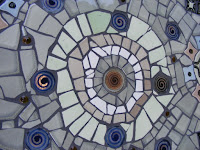a forest themed mosaic framed mirror
an easy project for beginners
PART TWO: How to Mosaic for beginners
1) Prepare your surface:
Sandpaper and apply bonding liquid onto your surface and allow it to
dry.
2) Choose your design and colors.
Make a pencil sketch on your surface if you can. When planning your composition- try and imagine it in the mind’s eye. Perhaps the focal point should be slightly off centre? Try and make sure your colors are balanced and complimentary. Don’t give yourself any difficult shapes to fill. Start with flowing lines, rather than an intricate pattern. For example, an underwater scene can have a flowing wavy background, with fish inserts swimming through it. Draw the pencil lines, place the fish over them, here and there, and then position the small broken glass tiles down, as the background, using the penciled wavy lines as a guide. Do an entire wavy line in one color and then change color for the next one above. Use glass drops or a different texture, or a row of broken mirror pieces. The fish are swimming over the wavy lines. When doing the background of a tree mosaic, the wavy lines would be distant hills. They don’t flow around branches, so make sure the background doesn't get too confused with the foreground, unless you want it to.
Note that I haven’t started using adhesive yet. I only start sticking the pieces down when I am happy with the design and colors. When trying to visualize the end product, remember that the grouting process changes the mosaic considerably- it pulls the design together.
3) Cutting Glass, Mirror, & Ceramic tiles:
Use glass mosaic cutters. They have two round blades that you squeeze together and they snap the piece in half with ease. Practice using them by cutting lots of squares, rectangles and some triangles. If you limit yourself to these shapes it will go quicker (and you will develop a similar style to mine.) As you place a piece down- look at the space you leave behind. Are you leaving yourself a big angled confusion or an easy shape? Sometimes just trimming a corner off makes your next piece easier to place.
4) Placing your pieces down
Place your pieces onto your design, and trim off the bits that are “in the way”, i.e. hold your piece over the place where you want it to go, and trim off the corner that is in the way. My rule is that pieces should be close together, but not touching. Grout is important and adds strength to the mosaic. Later, when everything is glued down and dry, the grout must be able to surround each mosaic piece. I sometimes take it a step further and grind down the sharp edges on the glazed ceramic pieces, or mirror, as they can be horribly sharp.
5)Now Just Get On with it
Tile adhesive- in South Africa we have the pasty, ready mixed white glue in a 1kg bucket, or mosaic adhesive (white cement) or grey powdery tile adhesive that you add water to. I usually use the ready mixed ones, but still use the old fashioned tile adhesive if working onto a concrete surface, like a water feature, birdbath, umbrella stand or shower floor. I always add bonding liquid to it to make it waterproof and stronger as well. Follow the instructions on the container, even if you need to get your reading glasses!
Now that you have your design, and your pieces, you just have to start on one side and work methodically to the other side. If you have an assistant at this stage, it really helps. Artist positions the pieces, helper glues down. Use a stick or spatula of sorts to apply just enough glue to the back of the piece. You don’t want adhesive squishing out messily from under the piece as that will mean cleaning later to prepare for the grout. Not too little either. It must cover the back of the piece and be pressed down firmly. You will have a little while to adjust its position before it sets. If there is old adhesive or a scrap of broken tile under your piece, it will stick up above the other pieces and look and feel wrong, so make sure it is a clean flat surface you are sticking your piece onto.
You can get away with applying the glue to the surface in one long strip and then applying your pieces, but first do it the hard way, until you are accustomed to the glue you are using and its drying time etc.
Have a damp sponge handy and clean your hands and then the mosaic, gently. Some glues are hell to clean afterwards when they are dry, so try not to be too messy and use a matchstick or whatever, to clean off excess adhesive from between the pieces as you go.
Once you are satisfied you have glued everything down, clean it one more time and leave it to dry for 12 hours or so.
The next stage will be the grouting stage.
The picture below shows the glass mosaic cutters. This commission was for an abstract theme with circles, mosaic framed mirror in fynbos tones










































